Sighisoara is Romania’s best-preserved medieval town, a genuine Transylvanian tourist pearl, transformed in recent decades into a major attraction for Romanian and foreign tourists on holiday or traveling in the center of the country.
The city located in Mures county has a population of about 30,000 inhabitants and magnetizes its visitors with its historical center, included in the UNESCO World Heritage Site. Sighisoara was founded by German settlers (craftsmen and merchants) who arrived in Transylvania at the initiative of the Hungarian king Géza II. These were later known as the “Transylvanian Saxons.” The first documentary mention of the village comes from 1280, under the name Castrum Sex, which speaks about a settlement founded on the ruins of a former Roman castrum.

First fortified in 1350, Sighisoara has had a tumultuous history, including the birth of Vlad the Impaler (in 1431) and numerous attacks by various nations and groups, by plague epidemics or fires. More or less, all these interesting histories are found today in buildings and monuments in the old center of the village. For first-time travelers, here are 10 places to visit in Sighisoara, a mini-guide regarding what to do and what to see in the medieval jewel of Romania.
10 places to see in Sighisoara, Romania
The Church on the Hill
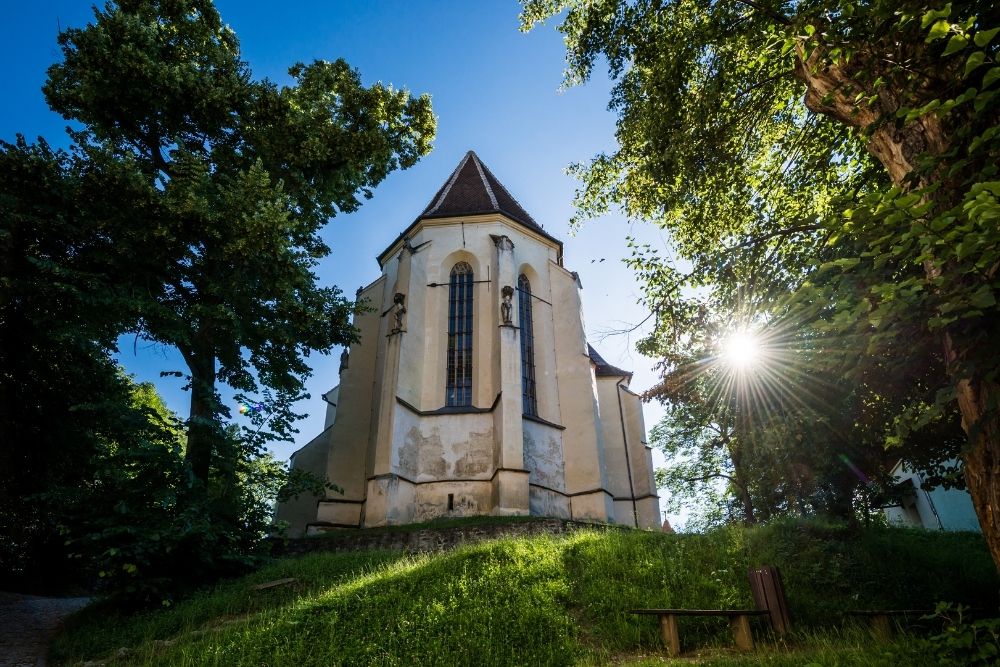
Built in the Gothic style, on the School’s Hill (429 meters high), between 1345 and 1525, and dedicated to St. Nicholas, the Church on the Hill is considered a significant architectural landmark of Sighisoara.
The Church on the Hill had two renovations, the first in 1934, the second in 1992-2003 – being awarded the Grand Prix of the European Union for the patrimony importance. It is a massive church, which is distinguished mainly by the frescoes on the inside, painted after 1480 by (most likely) Valentinus Painter and Jakobus Kendlinger. The renovations were of particular importance, as they unveiled the frescoes covered with paint on the occasion of the transition to Lutheranism of the Transylvanian Saxons in 1544.
Inside the Church, there are many tombstones (one of which belongs to former Mayor Stephanus Mann) and a baptizing font. Below is a crypt with 60 tombs from the 16th to 18th centuries. 16), painted by Johann Stoss, son of Veit Stoss, famous sculptor of Nuremberg.
Address: Str Scarii nr. 10.
The Tower with Clock
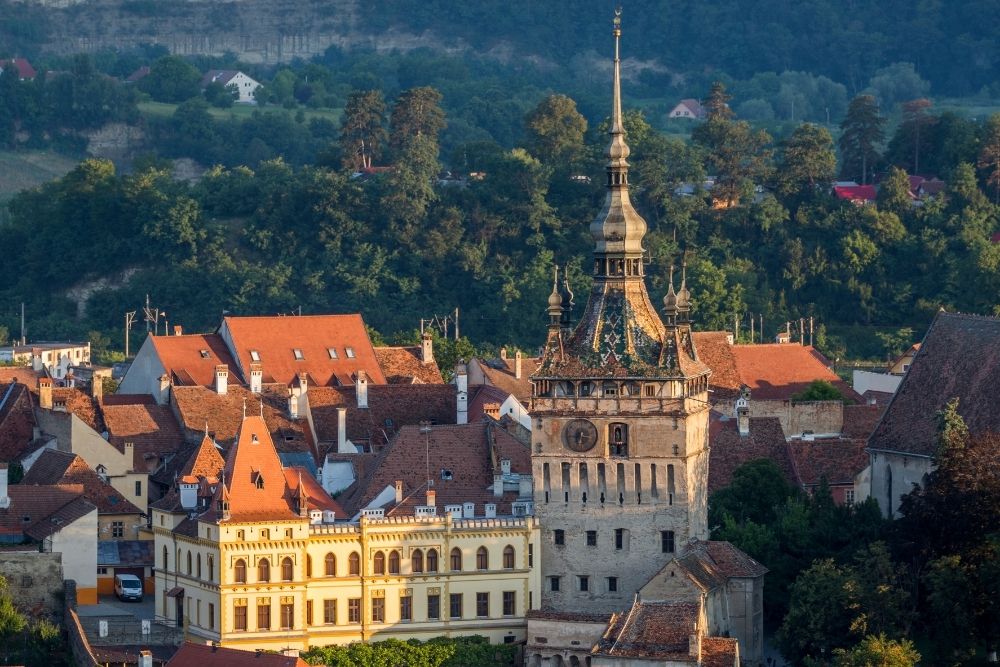
The Stundturm, or “Hours’ Tower,” as the German name of the Sighisoara Tower’s with Clock, was built in the 14th century, with the main entrance gate to the city. In the beginning, it was a simple two-level defense tower (one of the 14 built across the fortresses walls). It was later developed in an ensemble with baroque elements (after the fire in 1676), such as the roof and the four towers in the corners, which symbolized the legal autonomy of Sighisoara, whose town advice could make the decision to apply the death penalty.

The Clock in this tower is unique and was installed in 1648 at the fourth level. The new Clock was mounted in 1906, its mechanism being executed in Switzerland. The most exciting part is the seven figures made of linden wood, reminding of the gods personifying the days of the week: Diana, Mars, Mercury, Jupiter, Venus, Saturn, and the Sun. Above them are the faces of the goddesses of Peace and Justice.
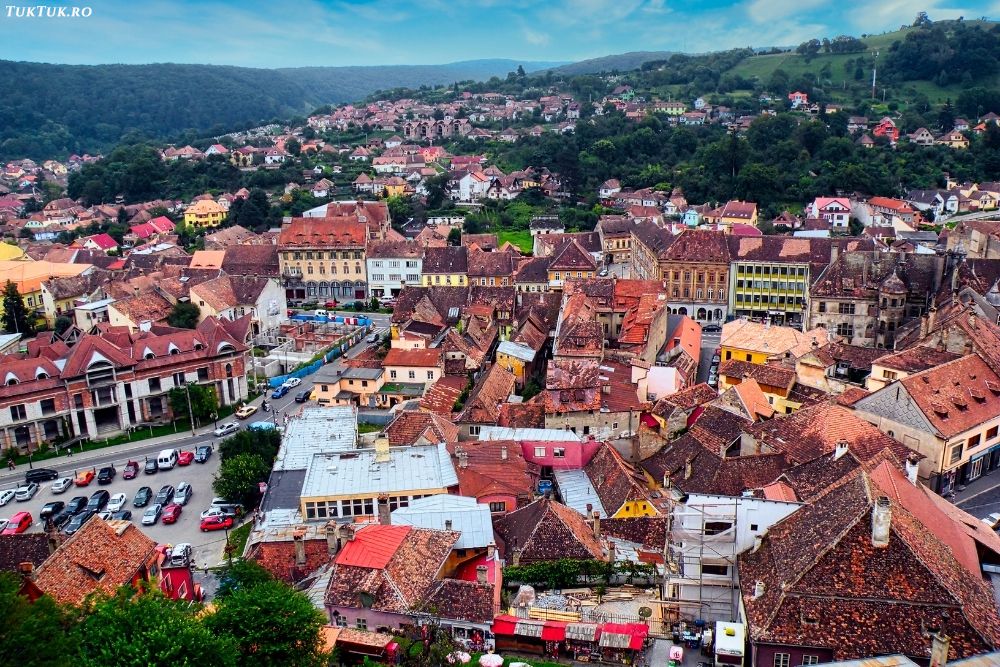
Until 1556, the Clock Tower sheltered the City Council Hall, then the guard’s house, the weapons depot, the court, and the prison. Since 1899 the Sighisoara History Museum has been located in the tower. Today, the Tower with Clock is one of the main tourist attractions in Sighisoara, a climb in the pavilion of the six-story building, 64 meters high, offering the chance to enjoy superb panoramic views of the city.
Address: Strada Turnului, Sighisoara.
Museum of History and the Torture Chamber
The entrance ticket to the Tower with Clock gives you permission to visit two museums: The History Museum of Sighisoara and the Torture Chamber.
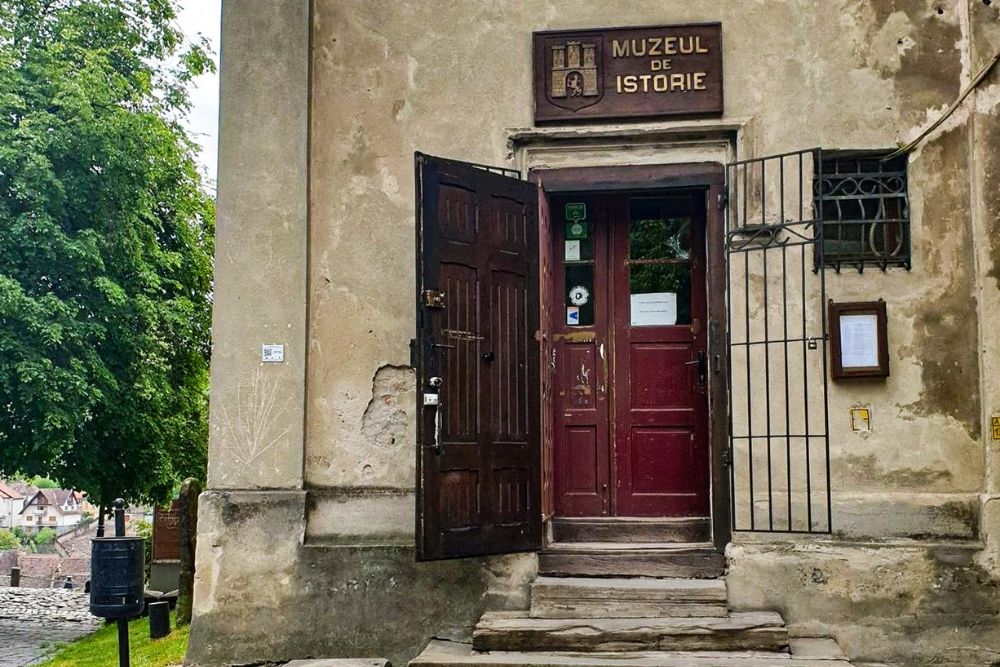
The History Museum was opened on June 24, 1899, at the initiative of a passionate local man – doctor Josef Bacon who, together with numerous collaborators, laid the foundation of this objective through the scientific systematization of collections. Later, the museum’s collections were enriched with valuable pieces from archeology, crafting, etc. The primary attraction is the collection of icons on glass and wood belonging to ethnographer Gheorghe Cernea.
In fact, the museum is organized on themed halls: Archeology Hall, Peasant Furniture Hall, Pharmacy Hall, Furniture Hall, Guilds Hall, Ceramic Hall, and, on the fifth level, the Clock Mechanism (where you can admire watches from various periods of mankind, from a solar clock and an hourglass of 18th century to pendulums and locally crafted watches.

The Torture Chamber. A small prison was arranged following the 1676 fire, which destroyed a large part of the Sighisoara Citadel inside the Tower with Clock, also affected by flames. Nowadays, that room has become part of the History Museum, under the name of Torture Chamber.
Here we find, in an exhibition of “torment” some objects used to torture villains and thieves of the Middle Age: chain shackles for hands and feet, other chains, gallows, a yoke and a torture ladder, a stone that was hung from the necks of the convicts, etc.
The (Dominican) Monastery’s Church
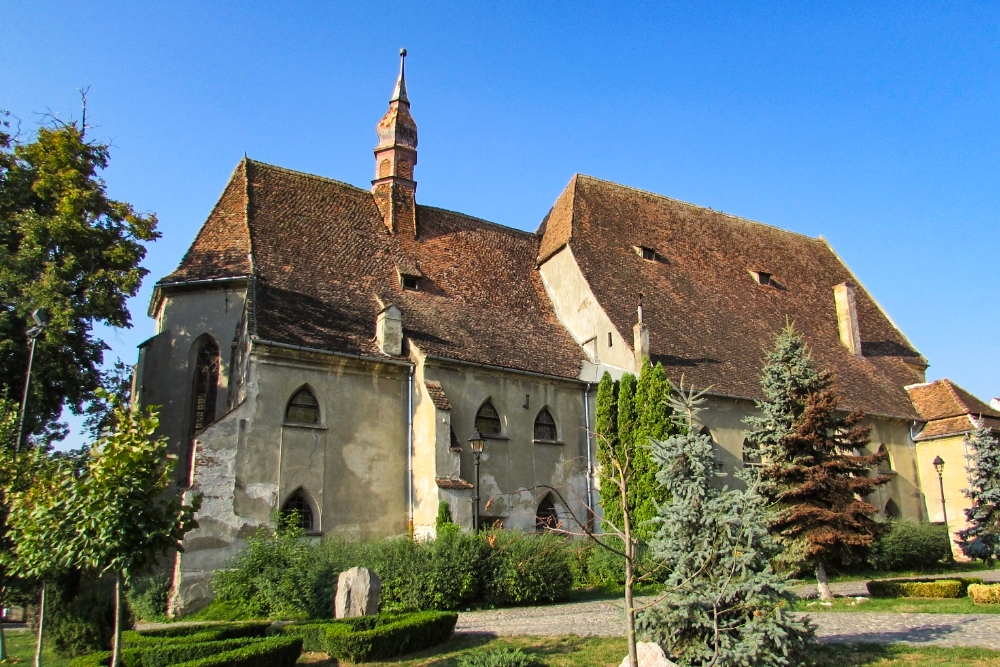
Built in Gothic style between 1492-1515, on a former Dominican church of the 13th-century place, and attested in 1288, the Monastery’s Church (Klosterkirche, in German), located near the Tower with Clock, in the Fortress Square, is the oldest monument in Sighisoara.
The Church’s history is a tumultuous one, marked by the fire of 1676 when it was devoured by flames. It was restored, having three naves of equal heights, with a mix of styles on the inside, because of the numerous extensions and renovations carried out over time. The Gothic style was joined by a Renaissance frame, then another Baroque one, with the addition of the altar and organ.
The Monastery’s Church is an evangelical church, where visitors will discover at least two fascinating elements: a bronze font, dating back to 1440, made by master Jakobus (a famous bell tower) and the second-largest collection of oriental prayer carpets (after the one at the Black Church in Brasov) – 35 valuables, from the 16th and 17th centuries, originating from the Ottoman Empire and donated by the Saxon merchants who were trading with the Turks.
The Covered Staircase
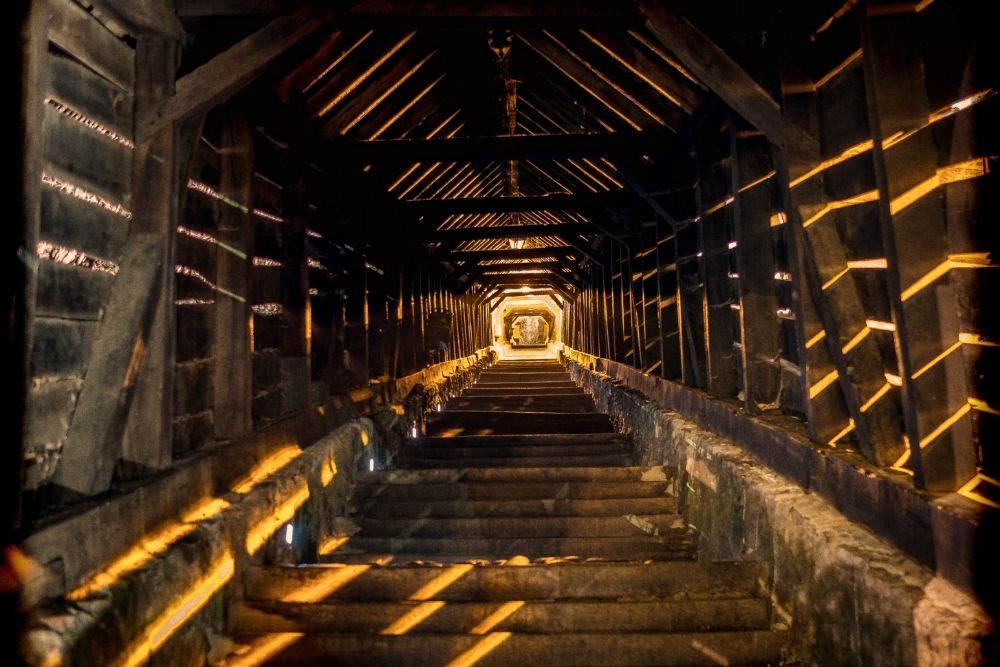
To reach the Church on the Hill, you have to climb 178 steps on a staircase covered with shingles. Built between 1660-1662, after an idea of Mayor Johann Both, the staircase initially had 300 steps and was covered to protect the children who used it to reach the School on the Hill (that’s why they also called it the School Ladder). It was modified in 1849 and renovated in 1965-66.
Similar to a tunnel of beams pierced by daylight, the covered staircase has a legend, according to which the boy who kisses his girlfriend on each step of the ladder, pronouncing her name correctly, will become the official “chosen” one. In case he misses her name once, this chance is gone forever.
The Sighisoara Fortress’ Towers
In the late Middle Ages, the Sighisoara Fortress was marking the border with the Ottoman Empire, where the town had to face numerous and repeated attacks and raids. Therefore, between 1300 and 1500, it was the task of the city guilds to build and manage several defense towers.
The fortress walls were erected in the 14th century, having a 14 meters thickness, but it had to be fortified, from place to place, with defensive towers.
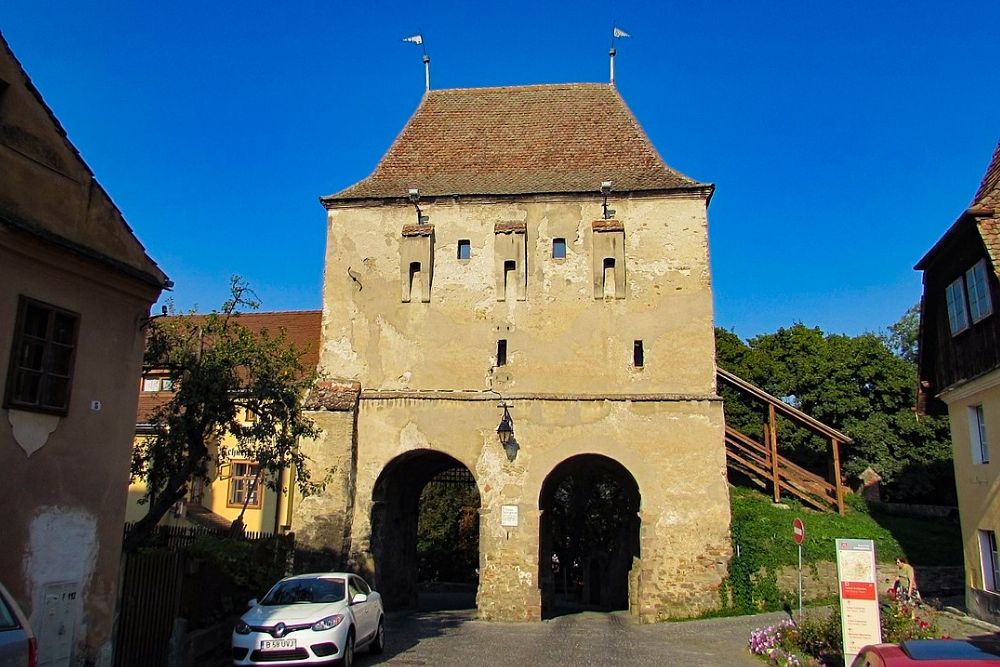
Tailors Tower / Photo by Cezar Suceveanu (Wikimedia) 
Tinnermen Tower / Photo by haidamac 
Smiths’ Tower / Photo by sighisoaraonline.com 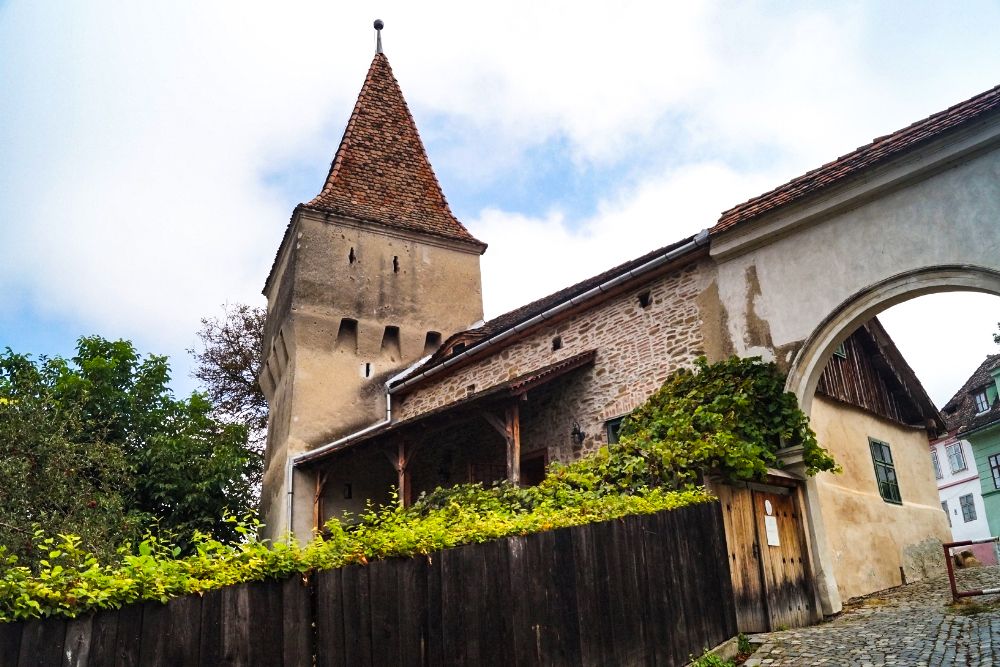
Furriers Tower / Photo by Ramona Georgescu 
Butchers Tower / Photo by Ramona Georgescu 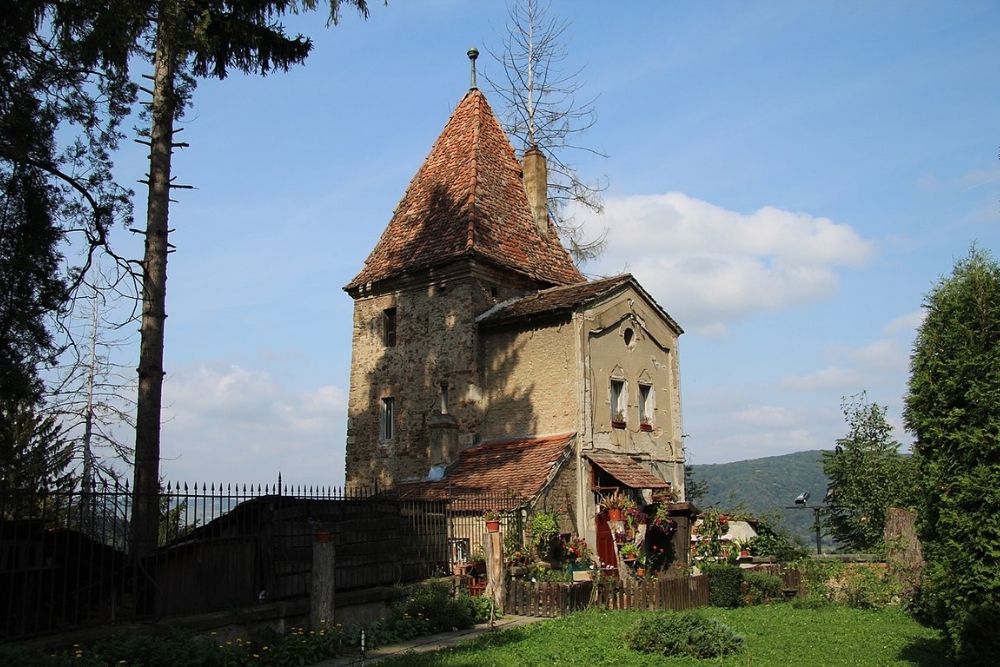
Ropers Tower / Photo by GerritR (Wikipedia) 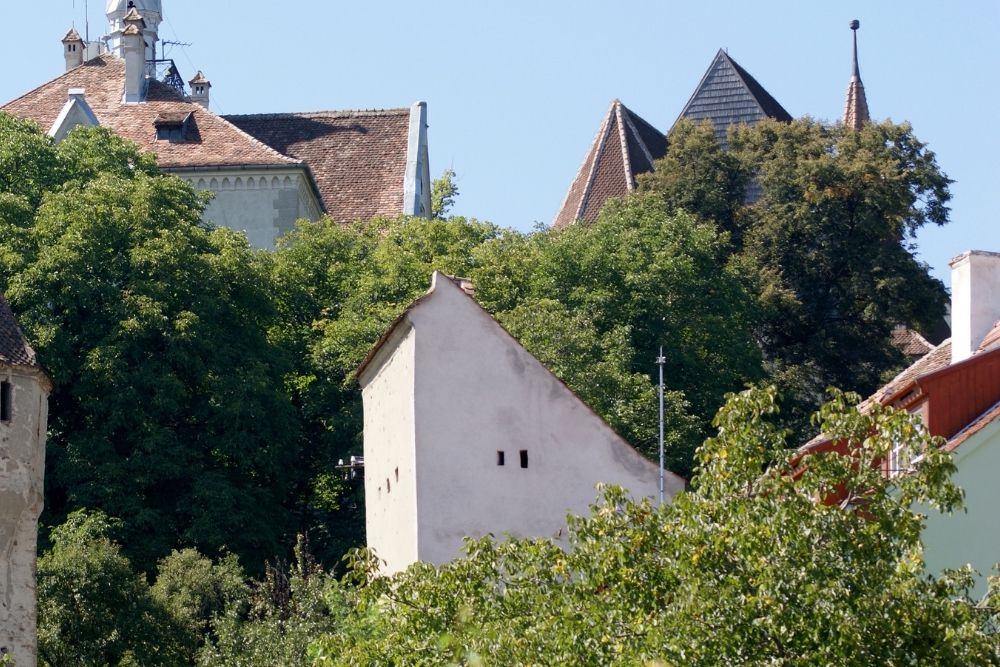
Tanners Tower / Photo by prill 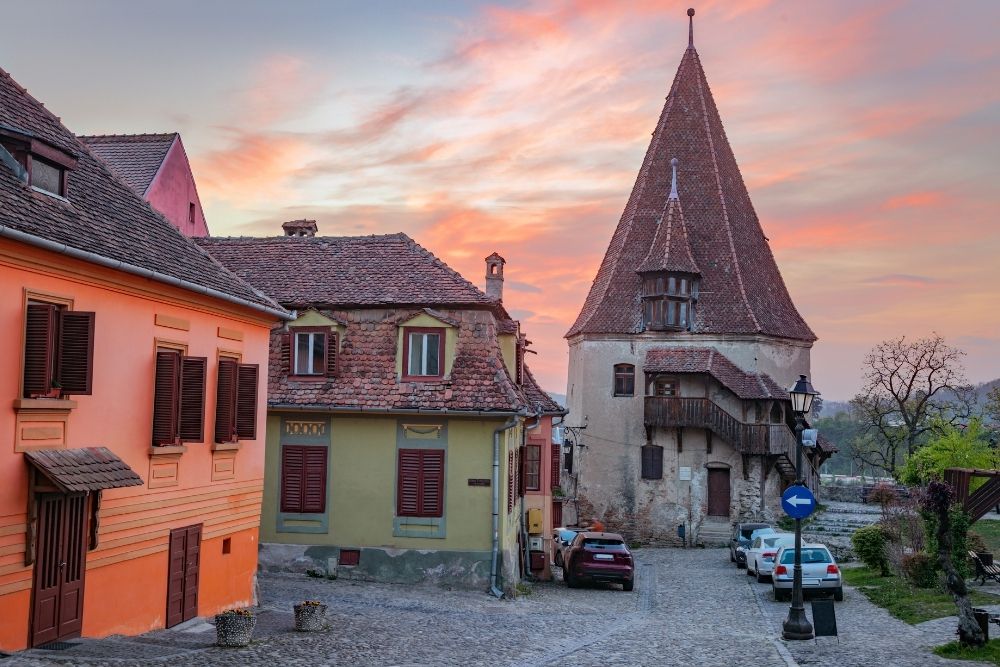
Shoemakers Tower / Photo by benkrut
The town’s craftsmen built 14 such towers (14 seem to be a magic figure in Sighisoara), 9 of which “survived” to our days, good or excellent preserved. The destroyed towers were the Weavers’ Tower (fallen in 1858), the Fishermen’s Tower (located on the bank of Târnava river), the Goldsmiths’ Tower (set on fire in 1809, on its place, there is a chapel in a cemetery, it was one of the strongest towers, belonging to the richest guild), the Locksmiths’ Tower (a small tower) and the Coopers’ Tower (demolished in 1886) – the last two located between those of the Shoemakers and Blacksmiths, while the remaining towers are as follows:
- The Tower with Clock, which is the most important (describes above)
- The Rope Tower – is located on the Hill School plateau. It served as home to the guardian of the Evangelical Cemetery and his family. It was restored in the 19th century.
- The Butchers Tower – finished in the late 15th century, had the form of a prism with eight sides, being restored a century later with a hexagonal base and three floors.
- The Furriers Tower – was destroyed in the great fire of 1676, but it was later rebuilt, having four floors. It’s the tower that defended the Törle Gate.
- The Smiths’ Tower – built in 1631, is located in the northeast and has a rectangular plan, being the work of the former mayor Eisenburger. It was also destroyed in the fire, later rebuilt.
- The Tinnermen Tower – defend the city on the same Tower with Clock line. It’s four stories tall, 25 meters high, and it has bizarre architecture, which starts with a quadrilateral, so it becomes pentagonal in the middle, then octagonal. On its walls, we still see traces of the cannonballs from the Kurutds’ siege from the beginning of the 18th century.
- The Tailors’ Tower is one of the most beautiful and majestic towers of the Citadel, being erected in the 14th century opposite the Tower with Clock. It is based on two canopy gangs, above which rises two levels. It was rebuilt after the fire in 1676 under the orders of Mayor Michael Helwig.
- The Shoemakers Tower – a hexagonal tower located in the northeast, equipped with two smaller observation towers. It was first mentioned in 1521, then destroyed during a siege and rebuilt in 1650, destroyed once again by the great fire, and built again in 1681, in Baroque style.
- The Tanners Tower – An old and simple tower on a square plan to defend the fortress court.
The House with Stag
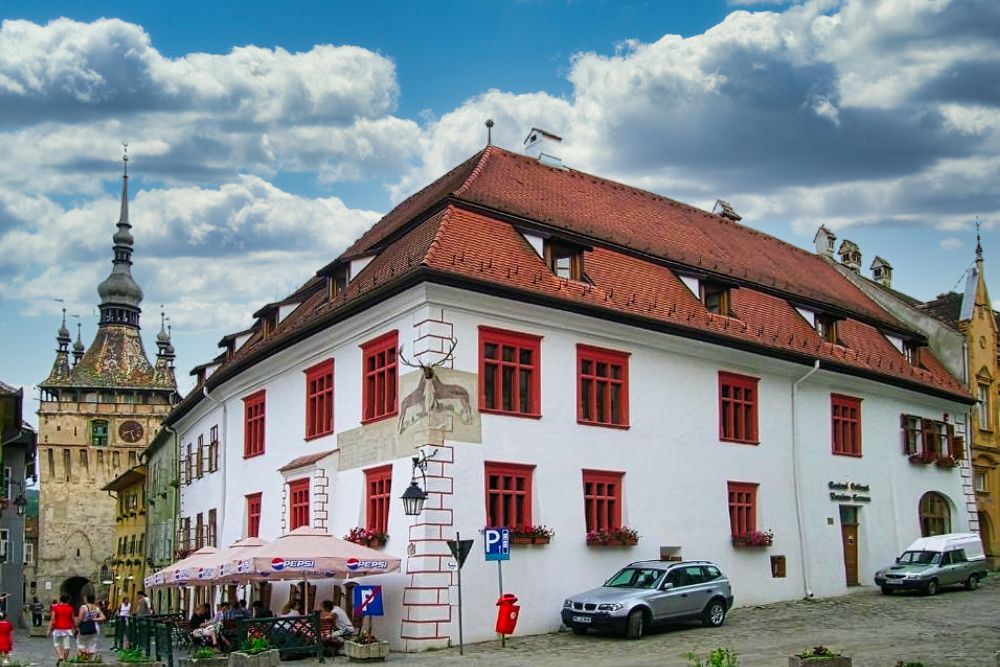
Walking on the streets of Sighisoara Fortress is a delight for everyone. At every step, there is a reason to admire some of this medieval town’s architecture, so well preserved. The colorful walls of the old houses create a great state of mind.
One of the city’s famous attractions is the House with Stag, a building that received this name due to the natural size deer head attached to its corner. In the Transylvanian Renaissance style, the house was initially built in the 17th century (on a wooden house site, dating from the 13th century), being restored between 1997-2001.
Over time, private persons with administrative or judicial functions lived here. Currently, there is a pension and a restaurant and a Romanian-German cultural center.
Vlad Dracul House
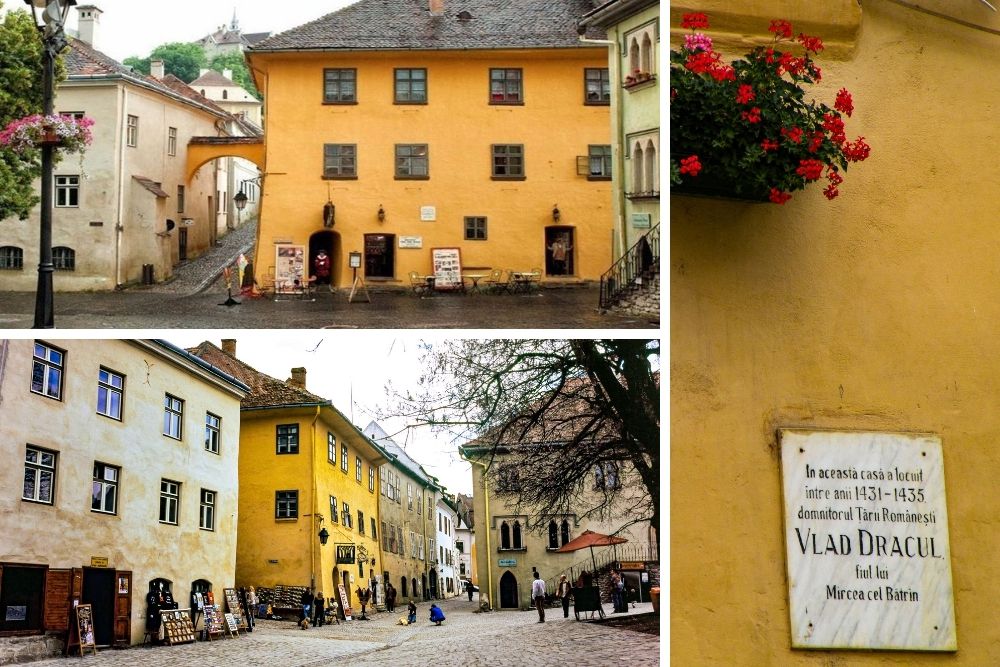
Speaking of walks on the streets of Sighisoara, it is quite possible to come across a house on whose yellow wall is a plaque regarding Vlad Dracul, “the son of Mircea cel Batran”. It operates a restaurant with a terrace and a bar, but the building itself has a special significance because it is assumed that here was born (in 1431) and lived until the age of four, Vlad the Impaler himself.
The assumption is that ruler Vlad Dracul, who was Vlad the Impaler’s father, even lived here. Two letters he sent to Brasov have specific requests related to Sighisoara, so this could be the proof. Regarding Vlad the Impaler, things are not as safe as for his father – there is no evidence of his birth in this house. But, as we must learn from Americans to build plausible legends around tourist attractions, the House of Vlad Dracul remains a place where you can stop drinking a beer in memory of Dracula. Or, at least, his father’s.
Fortress Square
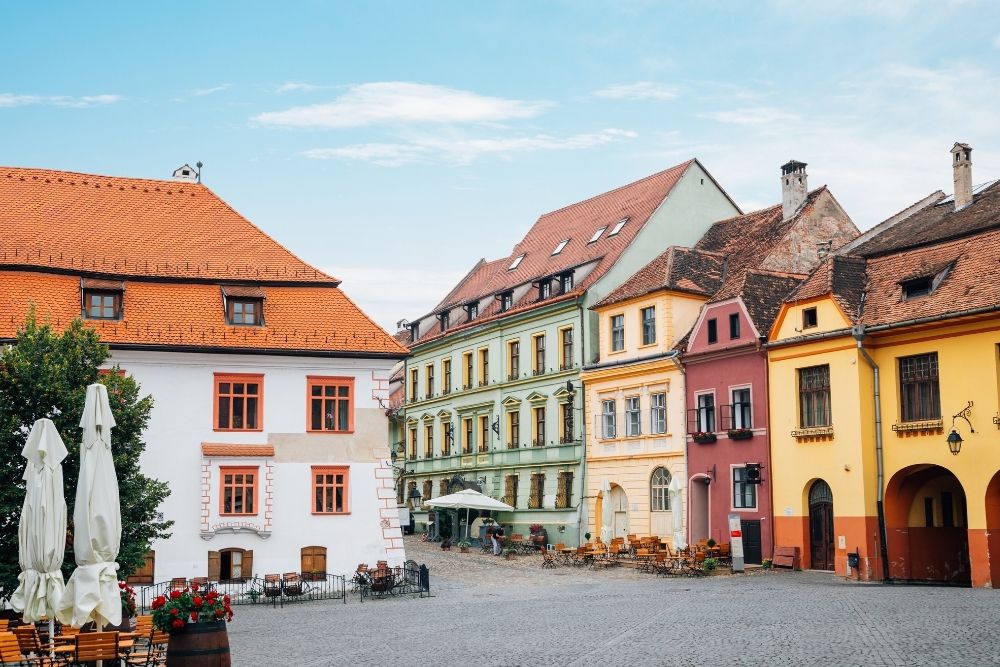
The central square of Sighisoara is the place where all the gatherings used to be held, and all the important events of the fortress took place, from ceremonies and fairs to public executions. Here was, temporarily, the place of the “pillar of infamy”, to which were connected the criminals and witches who received a public judgment
Fortress Square was built after the fire of 1676, which destroyed most of Sighisoara. Then new houses appeared, the old ones suffering changes of the façades burned by flames.
Today, Fortress Square is where tourists can purchase various souvenirs and handicrafts from craftsmen who come here to exhibit their work. They can relax on a terrace, admiring the colorful old houses and imagining how life unfolded in the days of the Middle Ages.
Breite Nature Reserve
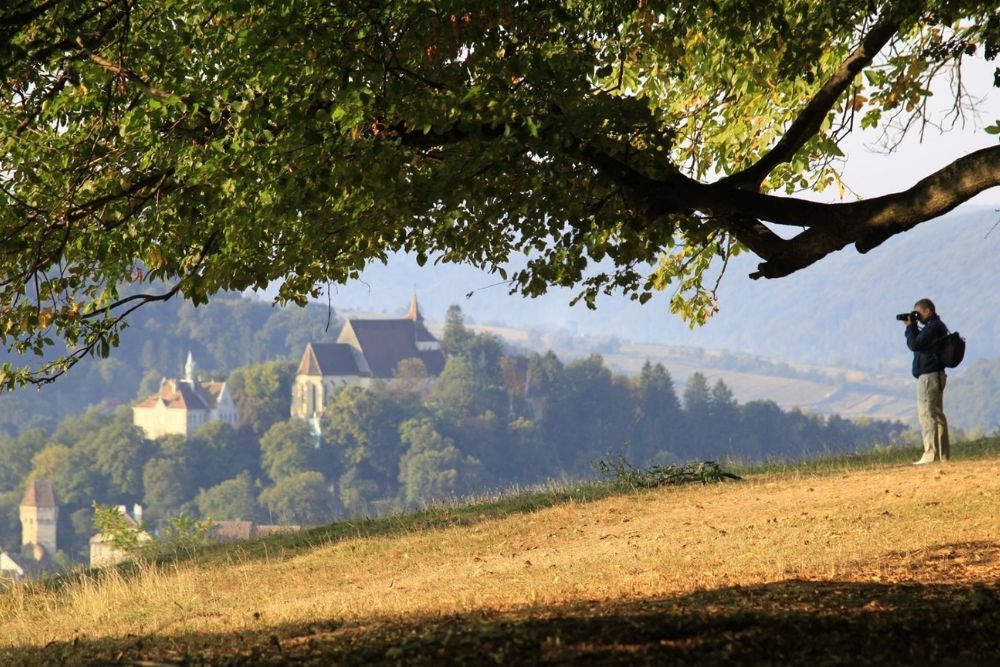
In case you want to spend a few hours in the middle of nature, you must know that on the Breite plateau, near Sighisoara, there is the Breite Reservation. It’s a superb area (133 hectares) forested with multi-secular oaks and sessile oaks, the best preserved of its kind in central and eastern Europe.
It is the place where you will discover trees of up to 600-700 years of history and many species of birds and animals (lizards, woodpeckers, bats, butterflies, etc.). To reach the meadow of the Breite Reservation (walking or by bike), you must follow the route starting from Ana Ipătescu Street and continue the path to the forest, to the plateau area (marked with red stripe, then, after 6 km, a blue stripe).
You may also like: Poenari Fortress: 1480 steps to Vlad the Impaler’s Nest




